We’ve been experimenting with alternative lenses on the Leica S2 for the better part of a year now, trying to see which lenses perform best and offer an S2 user some kind of additional functionality or creative possibilities. Some basic lenses, like the Hasselblad 80mm f/2.8 CF, have no real benefit as the Leica 70mm Summarit-S ASPH offers a faster maximum aperture, weather sealing, autofocus and superior image quality in just about every measure. Then, we have specialty lenses. These are the ones that interest me – ones that offer something different. A lens we’ve been wanting to test for some time is the SMC Pentax 105mm f/2.4. The lens is generally well-regarded among Pentax 67 users, especially for shallow depth-of-field portraiture. After getting my hands on one, I figured a test was in order and put it head to head against the outstanding Leica 120mm f/2.5 APO-Macro-Summarit-S.

How does the Pentax 67 105mm f/2.4 stack up against Leica’s 120mm f/2.5 on the S2? Setting aside that the Leica is a macro lens and the Pentax is not, both offer a similar focal length and almost the same maximum aperture (within a 1/10th of a stop). Instead of breaking out the test charts, I decided to give the lenses a head-to-head test on the streets of Old Fort Lauderdale.
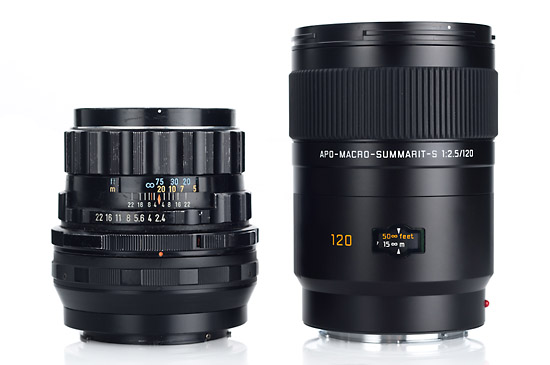
Pentax 105 (with P67 to S adapter) and Leica 120 side-by-side
Almost any decent lens can perform well at f/8-f/11, so I was really curious to see how these two fast-aperture short teles would measure up when shot wide-open. I figure if you're going to go with a fast lens, you're going to want to use it to reap low-light advantages and/or use the shallow DOF for creative use.
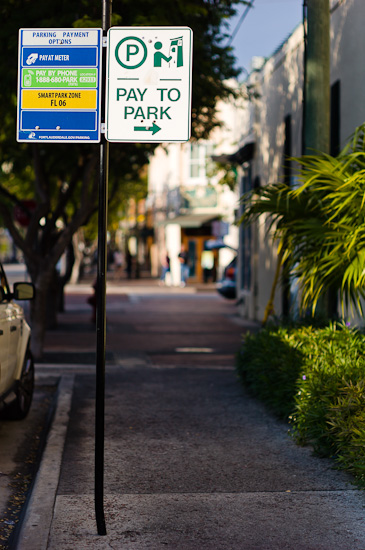
Leica S2 with Pentax 105mm
1/4000th @ f/2.4, ISO 320
100% crop
Testing
I didn't use a tripod or cable release when shooting these tests. I also didn't move closer to the subject with the 105mm to match the framing of the 120mm. My technique was simple: wander around looking for photos, take a shot, then without moving my feet, change lenses and shoot the same basic picture at the same aperture setting (letting the camera’s meter determine shutter speed) and try to select the same focal point. I used autofocus for the 120 and manual focus for 105. My goal wasn't to shoot under perfect, ideal conditions. Rather, I wanted to see how each would work in an actual shooting scenario. Now, these happened to be pretty easy conditions – good weather, plenty of sunlight, no deadline, no pressure. Just a nice Sunday stroll around Old Fort Lauderdale with non-moving subjects.
On the processing side, all images were converted in Adobe Lightroom 3.4.1 using my standard S2 preset. For each pair of shots, the same white balance, tone curve and sharpness settings were used. The only difference was some minor exposure adjustment to better match the two shots to each other and eliminate minor metering differences.
This first pair of flower shots is just to show the overall feel of the different lenses at close focus. The Pentax was right up against minimum focus distance, while the Leica, of course, still had more room to go being a macro lens. Both were shot from roughly the same distance, and the greater magnification of the 120 is pretty clear. Note the color difference as well. The same white balance was used for both shots, so the difference is in the lens.
Below is another shot just to get a feel for image rendering and focus transitions. The Pentax has a pleasing bokeh, but the greater contrast and sharpness of the Leica makes the foreground snap more.
I ran across what I am assuming is a replica Shelby Cobra parked in a small off-street lot and figured this could be a good opportunity to examine how these two lenses handled chrome, which is notorious for revealing chromatic aberration (CA). As you can see, the Leica performs up to its APO namesake with virtually no CA. The Pentax is obviously not corrected for CA and shows quite a lot, with shifts from red/purple to green. As much as I tried to eliminate the aberration in Lightroom, the CA was never completed eliminated.
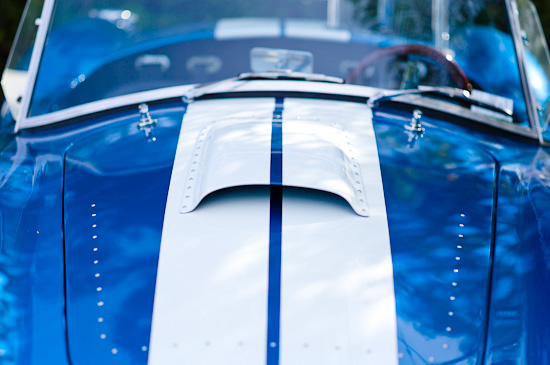
Leica S2 with Pentax 105mm
1/3000th @ f/2.4, ISO 320
100% crop
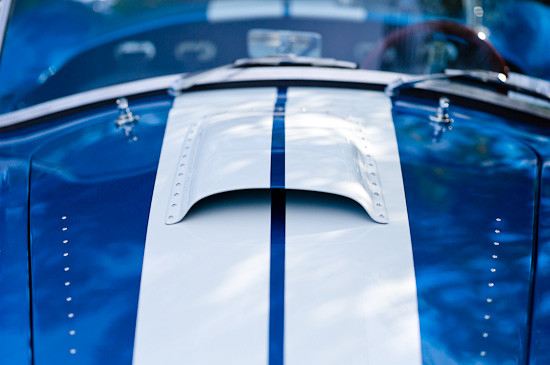
Leica S2 with Leica 120mm
1/3000th @ f/2.5, ISO 320
100% crop
In the interior of the car, the chrome-trimmed gauges and steering wheel are typically very prone to CA errors. Check out the 100% crop of the Leica shot for how chrome should look. Unfortunately, on this sequence, I didn't get the exact same shot for direct comparison, but the differences between the lenses are very obvious.
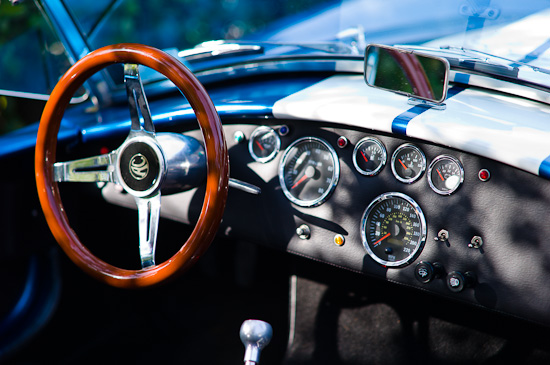
Leica S2 with Pentax 105mm
1/750th @ f/2.4, ISO 320
100% crop
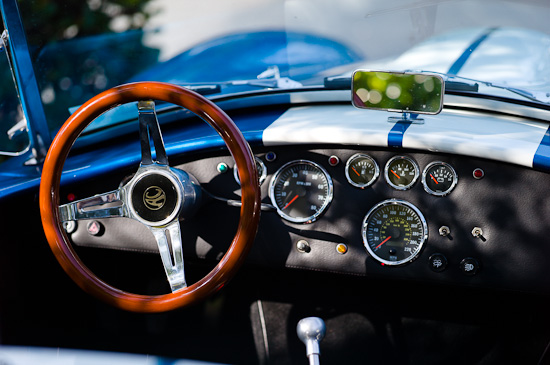
Leica S2 with Leica 120mm
1/1500th @ f/2.5, ISO 320
100% crop
Across the street from the car was a wooden gate in open shade. The chain made for a nice, detailed target. Not only is the chain a bit soft in the resulting Pentax image, but in this diffuse lighting the overall contrast of the image is extremely low – whites are muted and darks are washed out.
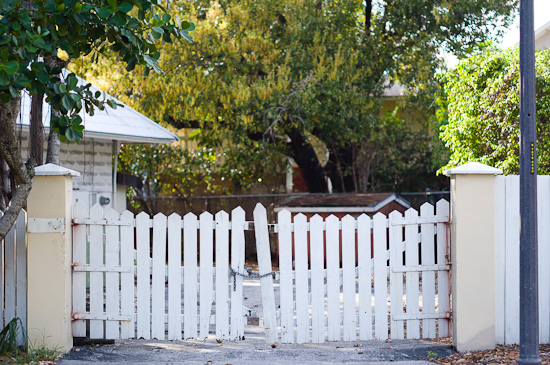
Leica S2 with Pentax 105mm
1/1500th @ f/2.4, ISO 320
100% crop
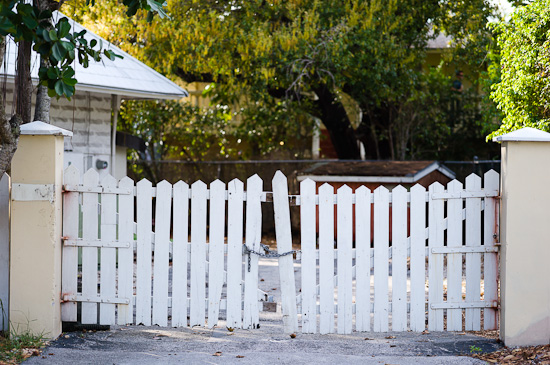
Leica S2 with Leica 120mm
1/1500th @ f/2.5, ISO 320
100% crop
The color of the images produced by the Pentax 105 are much cooler than those of the Leica 120, losing some of the natural warm tones from some of the subjects and the feeling of afternoon light. You can see this on the following image of the palm tree trunk. On the plus side, the drawing of the lens is pleasing with very smooth bokeh and nice tonal transitions, although hard edges sometimes surround bright out of focus elements.
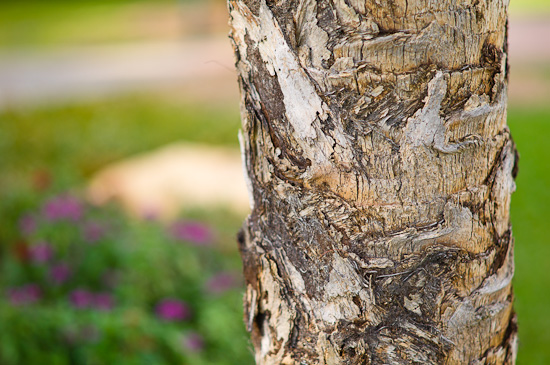
Leica S2 with Pentax 105mm
1/500th @ f/2.4, ISO 320
100% crop
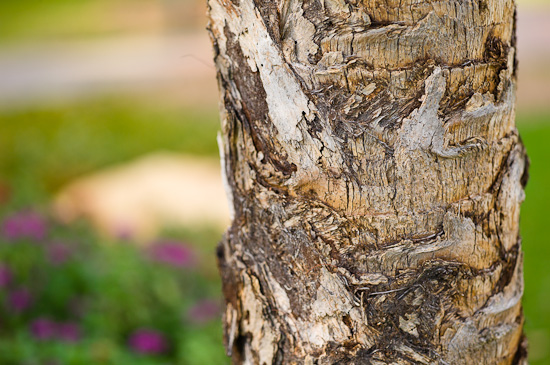
Leica S2 with Leica 120mm
1/500th @ f/2.5, ISO 320
100% crop
This next series of shots show relative performance at infinity. To level the playing field, I shot both at f/8. As an added bonus, you can see how the Leica 120 performed at infinity wide-open verses the Pentax 105 at f/8. It's really impressive. One the things to note is the moire on the building's air vents. The Pentax shows considerable moire while the Leica shows almost none, which can be attributed to the Leica's superior resolving power and color correction, as well as its slightly greater magnification.
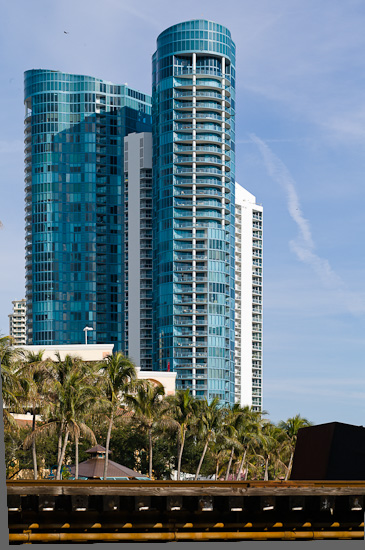
Leica S2 with Pentax 105mm
1/500th @ f/8, ISO 320
100% crop
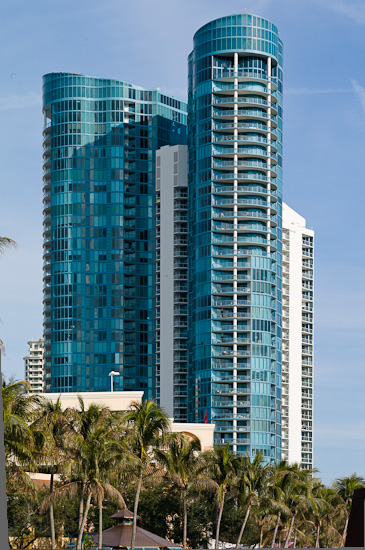
Leica S2 with Leica 120mm
1/500th @ f/8, ISO 320
100% crop
Just for grins: Leica 120mm @ f/2.5- 100% crop
Moving closer for middle distances, this railroad track provided some excellent details as well as showing the difference in color rendering again. These were shot towards the end of the day and the Leica lens accurately shows the warm coloration of the light. Look at the bright wall behind the tracks on the left side of the frame.
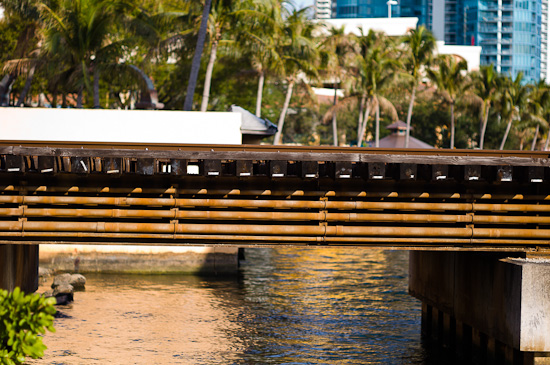
Leica S2 with Pentax 105mm
1/2000th @ f/2.4, ISO 320
100% crop
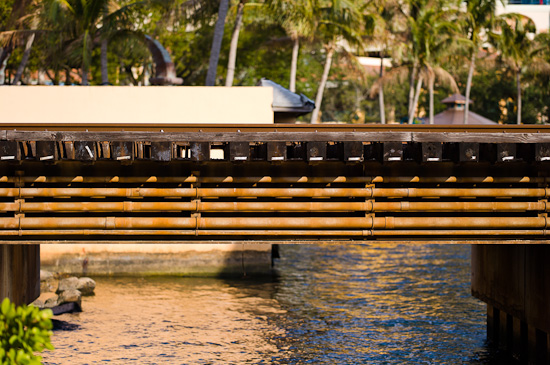
Leica S2 with Leica 120mm
1/3000th @ f/2.5, ISO 320
100% crop
In lieu of a brick wall, I went for the brightly colored wooden wall with a purple pipe. If you check out the crops of the pipe from the center of the image, the Pentax at f/5.6 still is not anywhere as sharp as the Leica is wide-open at f/2.5.
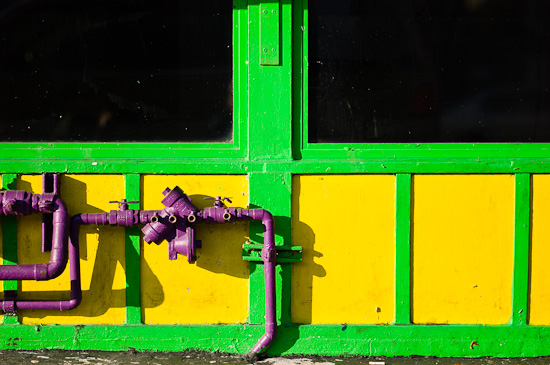
Leica S2 with Pentax 105mm
1/2000th @ f/2.4, ISO 320
P105 @ f/2.4 – 100% crop
P105 @ f/5.6 – 100% crop
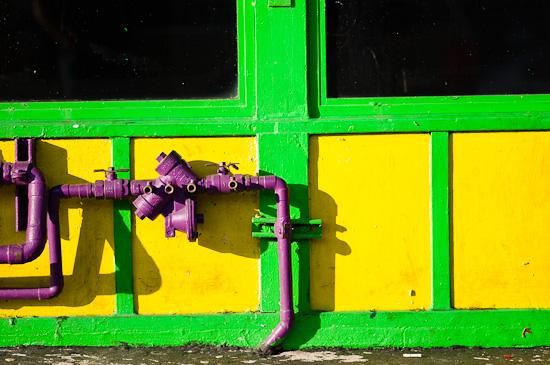
Leica S2 with Leica 120mm
1/1000th @ f/2.5, ISO 320
Leica 120mm @ f/2.5 – 100% crop
Leica 120mm @ f/5.6 – 100% crop
The Verdict
Admittedly, this wasn't a fair fight. It’s like comparing a birthday party pony past his prime versus a thoroughbred race horse on the same track. The differences become very obvious very quickly. As such, I think the results were predictable even before I shot a single frame. The Leica 120mm S is just a spectacular piece of optical engineering. No one has ever made an f/2.5 max aperture 120mm macro lens for medium format before, especially one that can resolve 40 lp/m at more than 80% contrast wide-open and performs as well at close range as it does at infinity. This is truly one of the best lenses Leica has ever produced. So, the deck was already stacked in the Leica lens' favor.
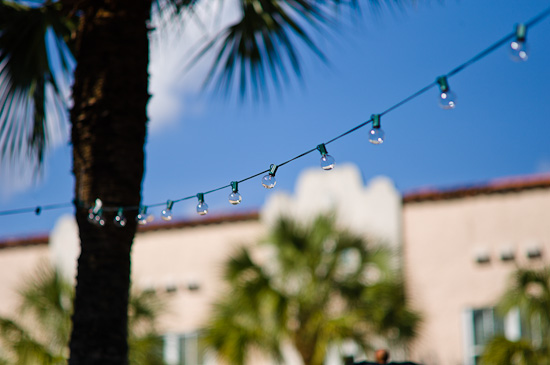
Leica S2 with Pentax 105mm
1/4000th @ f/2.4, ISO 160
100% crop – center | 100% crop – edge
The SMC Pentax 105 f/2.4 performed okay. For those wanting a fast portrait-length lens for the S2, it certainly does a decent job. At f/8 it is actually quite sharp. Wide-open, especially when compared to the Leica, the Pentax lens is pretty soft, with noticeably less sharpness and contrast. There is a good deal of CA which is not really correctable in software. Focusing on the S2 is easy and physically, the 105 is compact and light.
One of the nice things about these older alternative lenses is that they are very inexpensive and have already been fully depreciated. If you buy a P67 105 for $500 and use it for six months while saving up for the 120 S, you can probably sell it for the same $500, essentially getting free use for that time and not tying up very much money.
Alternative lenses like the P67 105 serve an important purpose (no, not showing how awesome the S lenses are). Not all S users will want or be able to justify having all the S lenses. A three lens kit like a 35, 70, 180 could be very well served by adding the P67 105 for the creative options it could add, and for the cost, it might be worth a try.
I created a new discussion thread on the forum for comments and feedback: Testing the Pentax 105mm f/2.4 vs. the Leica 120mm f/2.5 APO










Wow, that’s a lot of lens changes! Did you have two S2 bodies or one? Nice comps, useful info. I don’t think there’s any lens, including Leica’s, that can compete with a Leica lens that starts with “APO”, so the comps are not surprising. Interesting, nonetheless!
Roy
One body.
You’re exaggerating way too much in this post.
Show both set of images printed to any person that doesn’t know anything about the lenses used, and they wouldn’t have a clue which lens was used and when.
+1
The Pentax IR Focus index is close to F8. This is usually a good indicator of how much CA a lens will have in the visible band. Pentax made a series of “Ultra-Achromatic” in M42 mount lenses that were corrected from UV to IR bands. They do not have CA problems. I’m not sure if these were made for the larger format cameras. Corrected for inflation, they cost as much as the APO Summicron 50/2.
I see very little diference at all to be honest, and if you dont mind manually focusing a lens I cant imagine buying the lieca over then pentax considering the $7000 price diference.
David– You said that the 105 was not corrected for CA. It was, just not to the degree that the Leica was. After shooting this lens on film for 20+ years, I have never seen CA with it. The really interesting Pentax lens to try on the S2 is the 300mm EDIF (6X7): an APO lens with very low tertiary spectrum.
Both look great, but if you compare a physical print from the Leica body to a print from the Pentax 67 negative, it would be no contest in my opinion. The Pentax 67 print (the body that the 105mm lens was intended for) would blow the Leica print out of the water, in my opinion. Apples and oranges and personal preference, sure, but the photo is all I’m interested in the end.
Gabriel,
I’m not so sure I agree. Yes, a good quality print from a 6×7 original should be very nice indeed. But, I’ve seen prints from the S System at 5 feet across that are just stunning with incredible amounts of detail. It would be an interesting experiment for sure.
Very funny review.
Portrait lens compare to macro lens.
Film lens and lens optymised for digital sensors.
Few $100 to $6.500.
The Takumar in mounted via cheap adapter compare to the leica dedicated mount.
Old Pentax Takumar version of the series around 19(70 – 84) compared to modern camera dedicated lens.
This is a Asahi Takumar 6×7 1:24/105 and not a Pentax 67 105mm f/2.4.
And finally. The lens and camera doesn’t matter but the Takumar 6×7 and Pentax 67 105m shoots millions stories. I hope the Leica 120mm will also produce beautifule photos during and after 51 years!